History of the automobile: Difference between revisions
Tag: section blanking |
|||
| Line 159: | Line 159: | ||
===Future directions=== |
===Future directions=== |
||
{{Main|Future car technologies}} |
{{Main|Future car technologies}} |
||
==Further reading== |
|||
{{Refbegin}} |
|||
*Berger, Michael L., ''The automobile in American history and culture: a reference guide'', Greenwood Publishing Group, 2001. ISBN 9780313245589 |
|||
*[[David Halberstam|Halberstam, David]], ''The Reckoning'', New York : Morrow, 1986. ISBN 0688048382 |
|||
*Kay, Jane Holtz, ''Asphalt nation : how the automobile took over America, and how we can take it back'', New York : Crown Publishers, 1997. ISBN 0517587025 |
|||
*{{cite journal|last=Krarup|first=M. C.|year=1906|month=November|url=http://books.google.com/books?id=3IfNAAAAMAAJ&pg=PA8163|title=Automobiles for Every Use|journal=[[World's Work|The World's Work: A History of Our Time]]|volume=XIII|pages=8163–8178|accessdate=2009-07-10}} Includes photos of many c.[[1906]] special purpose automobiles. |
|||
*{{cite journal|last=Norman|first=Henry|year=1902|month=April|url=http://books.google.com/books?id=DoDNAAAAMAAJ&pg=PA3304|title=The Coming of the Automobile|journal=[[World's Work|The World's Work: A History of Our Time]]|volume=V|pages=3304–3308|accessdate=2009-07-10}} |
|||
{{Refend}} |
|||
Revision as of 15:09, 5 January 2010

The history of the automobile begins as early as 1769, with the creation of steam-powered automobiles capable of human transport.[1] In 1806, the first cars powered by internal combustion engines running on fuel gas appeared, which led to the introduction in 1885 of the ubiquitous modern gasoline- or petrol-fueled internal combustion engine. Cars powered by electricity briefly appeared at the turn of the 20th century but largely disappeared from commonality until the turn of the 21st century, when interest in low- and zero-emissions transportation was reignited. As such, the early history of the automobile can be divided into a number of eras based on the prevalent method of automotive propulsion during that time. Later periods were defined by trends in exterior styling and size and utility preferences.
Eras of invention
Pioneer inventors
German engineer Karl Benz, inventor of numerous car-related technologies, is generally regarded as the inventor of the modern automobile. The four-stroke petrol (gasoline) internal combustion engine that constitutes the most prevalent form of modern automotive propulsion is a creation of German inventor Nikolaus Otto. The similar four-stroke diesel engine was also invented by a German, Rudolf Diesel. The hydrogen fuel cell, one of the technologies hailed as a replacement for gasoline as an energy source for cars, was discovered in principle by yet another German, Christian Friedrich Schönbein, in 1838. The battery electric car owes its beginnings to Hungarian Ányos Jedlik, inventor of the electric motor, and Gaston Planté, who invented the lead-acid battery in 1859.
Early automobiles
Steam automobiles

Ferdinand Verbiest, a member of a Jesuit mission in China, built the first steam-powered vehicle around 1672, designed as a toy for the Chinese Emperor, it being of small scale and unable to carry a driver or passenger but, quite possibly, the first working steam-powered vehicle ('auto-mobile').[2][3]
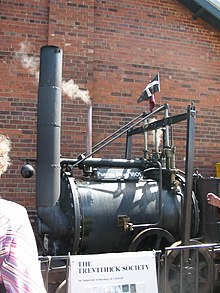
Steam-powered self-propelled vehicles are thought to have been devised in the late 18th century. Nicolas-Joseph Cugnot demonstrated his fardier à vapeur, an experimental steam-driven artillery tractor, in 1770 and 1771. Cugnot's design proved to be impractical and his invention was not developed in his native France, the centre of innovation passing to Great Britain. By 1784, William Murdoch had built a working model of a steam carriage in Redruth, and in 1801 Richard Trevithick was running a full-sized vehicle on the road in Camborne.[4] Such vehicles were in vogue for a time, and over the next decades such innovations as hand brakes, multi-speed transmissions, and better steering developed. Some were commercially successful in providing mass transit, until a backlash against these large speedy vehicles resulted in passing a law, the Locomotive Act, in 1865 requiring self-propelled vehicles on public roads in the United Kingdom be preceded by a man on foot waving a red flag and blowing a horn. This effectively killed road auto development in the UK for most of the rest of the 19th century, as inventors and engineers shifted their efforts to improvements in railway locomotives. The law was not repealed until 1896, although the need for the red flag was removed in 1878.
In Russia in the 1780s, Ivan Kulibin started working on a human-pedalled carriage with a steam engine. He finished working on it in 1791. Some of its features included a flywheel, brake, gearbox, and bearing, which are also the features of a modern automobile. His design had three roadwheels. Unfortunately, as with many of his inventions, the government failed to see the potential market and it was not developed further.[5][6]
The first automobile patent in the United States was granted to Oliver Evans in 1789. In 1805, Evans demonstrated his first successful self-propelled vehicle, which not only was the first automobile in the USA, but was also the first amphibious vehicle, as his steam-powered vehicle was able to travel on roadwheels on land, and via a paddle wheel in the water.
Among other efforts, in 1815, a professor at Prague Polytechnich, Josef Bozek, built an oil-fired steam car.[7]: p.27 and Walter Hancock, builder and operator of London steam buses, in 1838 built a four-seat steam phaeton.[7]: p27
Electric automobiles
In 1838, Scotsman Robert Davidson built an electric locomotive that attained a speed of 4 miles per hour (6 km/h). In England, a patent was granted in 1840 for the use of rail tracks as conductors of electric current, and similar American patents were issued to Lilley and Colten in 1847. Between 1832 and 1839 (the exact year is uncertain), Robert Anderson of Scotland invented the first crude electric carriage, powered by non-rechargeable primary cells.
Internal combustion engines
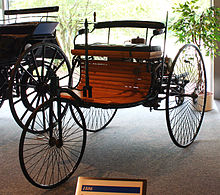

Early attempts at making and using internal combustion engines were hampered by the lack of suitable fuels, particularly liquids, and the earliest engines used gas mixtures.
Early experimenters using gasses included, in 1806, Swiss engineer François Isaac de Rivaz who built an internal combustion engine powered by a hydrogen and oxygen mixture, and in 1826, Englishman Samuel Brown who tested his hydrogen-fuelled internal combustion engine by using it to propel a vehicle up Shooter's Hill in south east London. Belgian-born Etienne Lenoir's Hippomobile with a hydrogen gas-fuelled one-cylinder internal combustion engine made a test drive from Paris to Joinville-le-Pont in 1860, covering some nine kilometres in about three hours.[8] A later version was propelled by coal gas. A Delamare-Deboutteville vehicle was patented and trialled in 1884.
About 1870, in Vienna, Austria (then the Austro-Hungarian Empire), inventor Siegfried Marcus put a liquid-fueled internal combustion engine on a simple handcart which made him the first man to propel a vehicle by means of gasoline. Today, this car is known as "the first Marcus car". In 1883, Marcus secured a German patent for a low-voltage ignition system of the magneto type; this was his only automotive patent. This design was used for all further engines, and the four-seat "second Marcus car" of 1888/89. This ignition, in conjunction with the "rotating-brush carburetor", made the second car's design very innovative.
It is generally acknowledged that the first really practical automobiles with petrol/gasoline-powered internal combustion engines were completed almost simultaneously by several German inventors working independently: Karl Benz built his first automobile in 1885 in Mannheim. Benz was granted a patent for his automobile on 29 January 1886, and began the first production of automobiles in 1888, after Bertha Benz, his wife, had proved with the first long-distance trip in August 1888 - from Mannheim to Pforzheim and back - that the horseless coach was absolutely suitable for daily use. Since 2008 a Bertha Benz Memorial Route commemorates this event.
Soon after, Gottlieb Daimler and Wilhelm Maybach in Stuttgart in 1889 designed a vehicle from scratch to be an automobile, rather than a horse-drawn carriage fitted with an engine. They also are usually credited as inventors of the first motorcycle in 1886, but Italy's Enrico Bernardi, of the University of Padua, in 1882, patented a 0.024 horsepower (17.9 W) 122 cubic centimetres (7.4 cu in) one-cylinder petrol motor, fitting it into his son's tricycle, making it at least a candidate for the first automobile, and first motorcycle;.[7]: p.26 Bernardi enlarged the tricycle in 1892 to carry two adults.[7]: p.26
One of the first four-wheeled petrol-driven automobiles in Britain was built in Birmingham in 1895 by Frederick William Lanchester, who also patented the disc brake and the first electric starter, was installed on an Arnold, in a copy of the Benz Velo, built between 1895 and 1898.[7]: p.25
In all the turmoil, many early pioneers are nearly forgotten. In 1891, John William Lambert built a three-wheeler in Ohio City, Ohio, which was destroyed in a fire the same year, while Henry Nadig constructed a four-wheeler in Allentown, Pennsylvania. It is likely they were not the only ones.[7]: p.25
Veteran era

The first production of automobiles was by Karl Benz in 1888 in Germany and, under licence from Benz, in France by Emile Roger. There were numerous others, including tricycle builders Rudolf Egg, Edward Butler, and Léon Bollée.[7]: p.20-23 Bollée, using a 650 cubic centimetres (40 cu in) engine of his own design, enabled his driver, Jamin, to average 45 kilometres per hour (28.0 mph) in the 1897 Paris-Tourville rally.[7]: p.23 By 1900, mass production of automobiles had begun in France and the United States. The first company formed exclusively to build automobiles was Panhard et Levassor in France, which also introduced the first four-cylinder engine.[7]: p.22 Formed in 1889, Panhard was quickly followed by Peugeot two years later. By the start of the 20th century, the automobile industry was beginning to take off in western Europe, especially in France, they produced 30,204 in 1903, representing 48.8% of world automobile production that year.[citation needed]


In the United States, brothers Charles and Frank Duryea founded the Duryea Motor Wagon Company in 1893, becoming the first American automobile manufacturing company. However, it was Ransom E. Olds, and his Olds Motor Vehicle Company (later known as Oldsmobile) who would dominate this era of automobile production. Its large scale production line was running in 1902. Within a year, Cadillac (formed from the Henry Ford Company), Winton, and Ford were producing cars in the thousands.
Within a few years, a dizzying assortment of technologies were being produced by hundreds of producers all over the western world. Steam, electricity and petrol/gasoline-powered automobiles competed for decades, with petrol/gasoline internal combustion engines achieving dominance in the 1910s. Dual- and even quad-engine cars were designed, and engine displacement ranged to more than a dozen litres. Many modern advances, including gas/electric hybrids, multi-valve engines, overhead camshafts, and four-wheel drive, were attempted, and discarded at this time.
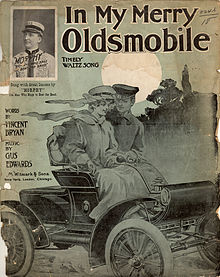
By 1900, it was possible to talk about a national automotive industry in many countries, including Belgium (home to Vincke, which copied Benz; Germain, a pseudo-Panhard; and Linon and Nagant, both based on the Gobron-Brillié),[7]: p, 25 Switzerland (led by Fritz Henriod, Rudolf Egg, Saurer, Johann Weber, and Lorenz Popp),[7]: p.25 Vagnfabrik AB in Sweden, Hammel (by A. F. Hammel and H. U. Johansen at Copenhagen, in Denmark, beginning around 1886),[7]: p.25 Irgens (starting in Bergen, Norway, in 1883, but without success),[7]: p.25-26 Italy (where FIAT started in 1899), and as far afield as Australia (where Pioneer set up shop in 1898 (with an already archaic paraffin-fuelled centre-pivot-steered wagon).[7] Meanwhile, the export trade had begun to be global, with Koch exporting cars and trucks from Paris to Tunisia, Egypt, Iran, and the Dutch East Indies.[7]: p25
Innovation was rapid and rampant, with no clear standards for basic vehicle architectures, body styles, construction materials, or controls. Many veteran cars use a tiller, rather than a wheel for steering, for example, and most operated at a single speed. Chain drive was dominant over the modern drive shaft, and closed bodies were extremely rare.
On 5 November 1895, George B. Selden was granted a United States patent for a two-stroke automobile engine (U.S. patent 549,160). This patent did more to hinder than encourage development of autos in the USA. Selden licensed his patent to most major American auto makers, collecting a fee on every car they produced. The Studebaker brothers, having become the world's leading manufacturers of horse-drawn vehicles, made a transition to electric automobiles in 1902, and gasoline engines in 1904, but they continued to build horse-drawn vehicles until 1919.[9]: p.90 In 1908, the first South American automobile was built in Peru, the Grieve.[10]
Throughout the veteran car era, however, automobiles were seen as more of a novelty than a genuinely useful device. Breakdowns were frequent, fuel was difficult to obtain, roads suitable for travelling were scarce, and rapid innovation meant that a year-old car was nearly worthless. Major breakthroughs in proving the usefulness of the automobile came with the historic long-distance drive of Bertha Benz in 1888, when she traveled more than 80 kilometres (50 mi) from Mannheim to Pforzheim, to make people aware of the potential of the vehicles her husband, Karl Benz, manufactured, and after Horatio Nelson Jackson's successful trans-continental drive across the United States in 1903.
Brass or Edwardian era

Named for the widespread use of brass in the United States, the Brass, or Edwardian era lasted from roughly 1905 through to the beginning of World War I in 1914. 1905 was a signal year[clarification needed] in the development of the automobile, marking the point when the majority of sales shifted from the hobbyist and enthusiast to the average user.[citation needed]
Within the 15 years that make up the Brass or Edwardian era, the various experimental designs and alternate power systems would be marginalised. Although the modern touring car had been invented earlier, it was not until Panhard et Levassor's Système Panhard was widely licensed and adopted that recognisable and standardised automobiles were created. This system specified front-engined, rear-wheel drive internal combustion engined cars with a sliding gear transmission. Traditional coach-style vehicles were rapidly abandoned, and buckboard runabouts lost favour with the introduction of tonneaus, and other less-expensive touring bodies.
Throughout this era, development of automotive technology was rapid, due in part to a huge number (hundreds) of small manufacturers all competing to gain the world's attention. Key developments included electric ignition system (by Robert Bosch, 1903), independent suspension, and four-wheel brakes (by the Arrol-Johnston Company of Scotland in 1909).[7]: p27 Leaf springs were widely used for suspension, though many other systems were still in use, with angle steel taking over from armored wood as the frame material of choice. Transmissions and throttle controls were widely adopted, allowing a variety of cruising speeds, though vehicles generally still had discrete speed settings, rather than the infinitely variable system familiar in cars of later eras.
Between 1907 and 1912 in the United States, the high-wheel motor buggy (resembling the horse buggy of before 1900) was in its heyday, with over seventy-five makers including Holsman (Chicago), IHC (Chicago), and Sears (which sold via catalog); the high-wheeler would be killed by the Model T.[7]: p.65
Some examples of cars of the period included the following:
- 1908–1927 Ford Model T — the most widely produced and available car of the era. It used a planetary transmission, and had a pedal-based control system.
- 1910 Mercer Raceabout — regarded as one of the first sports cars, the Raceabout expressed the exuberance of the driving public, as did the similarly-conceived American Underslung and Hispano-Suiza Alphonso.
- 1910–1920 Bugatti Type 13 — a notable racing and touring model with advanced engineering and design. Similar models were the Types 15, 17, 22, and 23.
Vintage era


The vintage era lasted from the end of World War I (1919), through the Wall Street Crash at the end of 1929. During this period, the front-engined car came to dominate, with closed bodies and standardised controls becoming the norm. In 1919, 90% of cars sold were open; by 1929, 90% were closed.[7]: p.7 Development of the internal combustion engine continued at a rapid pace, with multi-valve and overhead camshaft engines produced at the high end, and V8, V12, and even V16 engines conceived for the ultra-rich.
Exemplary vintage vehicles:
- 1922–1939 Austin 7 — the Austin Seven was one of the most widely copied vehicles ever, serving as a template for cars around the world, from BMW to Nissan.
- 1924–1929 Bugatti Type 35 — the Type 35 was one of the most successful racing cars of all time, with over 1,000 victories in five years.
- 1922–1931 Lancia Lambda — very advanced car for the time, first car to feature a load-bearing monocoque-type body and independent front suspension.
- 1925–1928 Hanomag 2 / 10 PS — early example of envelope styling, without separate fenders (wings) and running boards.
- 1927–1931 Ford Model A (1927-1931) — after keeping the brass era Model T in production for too long, Ford broke from the past by restarting its model series with the 1927 Model A. More than 4 million were produced, making it the best-selling model of the era.
- 1930 Cadillac V-16 — developed at the height of the vintage era, the V16-powered Cadillac would join Bugatti's Royale as the most legendary ultra-luxury cars of the era.
Pre-WWII era
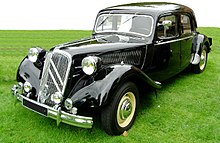
The pre-war part of the classic era began with the Great Depression in 1930, and ended with the recovery after World War II, commonly placed at 1948. It was in this period that integrated fenders and fully-closed bodies began to dominate sales, with the new saloon/sedan body style even incorporating a trunk or boot at the rear for storage. The old open-top runabouts, phaetons and touring cars were phased out by the end of the classic era as wings, running boards, and headlights were gradually integrated with the body of the car.
By the 1930s, most of the mechanical technology used in today's automobiles had been invented, although some things were later "re-invented", and credited to someone else. For example, front-wheel drive was re-introduced by André Citroën with the launch of the Traction Avant in 1934, though it had appeared several years earlier in road cars made by Alvis and Cord, and in racing cars by Miller (and may have appeared as early as 1897). After 1930, the number of auto manufacturers declined sharply as the industry consolidated and matured.
Exemplary pre-war automobiles:
- 1932–1939 Alvis Speed 20 and Speed 25 — the first cars with all-synchromesh gearbox.
- 1932–1948 Ford V-8 — introduction of the powerful Flathead V8 in mainstream vehicles, setting new performance and efficiency standards.
- 1934–1940 Bugatti Type 57 — a singular high-tech, refined automobile for the wealthy.
- 1934–1956 Citroën Traction Avant — the first mass-produced front-wheel drive car, built with monocoque techniques.
- 1936–1955 MG T series — sports cars with youth appeal at an affordable price.
- 1938–2003 Volkswagen Beetle — a design for efficiency and low price, which progressed over 60 years with minimal basic change.
- 1936–1939 Rolls-Royce Phantom III — V12 engined pinnacle of pre-war engineering, with technological advances not seen in most other manufacturers until the 1960s. Superior performance and quality.
Post-war era
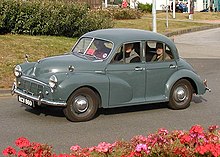


Automobile design finally emerged from the shadow of World War II in 1949, the year that in the United States saw the introduction of high-compression V8 engines and modern bodies from General Motors' Oldsmobile and Cadillac brands. The unibody/strut-suspended 1951 Ford Consul joined the 1948 Morris Minor and 1949 Rover P4 in waking up the automobile market in the United Kingdom. In Italy, Enzo Ferrari was beginning his 250 series, just as Lancia introduced the revolutionary V6-powered Aurelia.
Throughout the 1950s, engine power and vehicle speeds rose, designs became more integrated and artful, and cars spread across the world. Alec Issigonis' Mini and Fiat's 500 diminutive cars swept Europe, while the similar kei car class put Japan on wheels for the first time. The legendary Volkswagen Beetle survived Hitler's Germany to shake up the small-car market in the Americas. Ultra luxury, exemplified in America by the Cadillac Eldorado Brougham, reappeared after a long absence, and grand tourers (GT), like the Ferrari Americas, swept across Europe.
The market changed somewhat in the 1960s, as Detroit began to worry about foreign competition, the European makers adopted ever-higher technology, and Japan appeared as a serious car-producing nation. General Motors, Chrysler, and Ford tried radical small cars, like the GM A-bodies, but had little success. Captive imports and badge engineering swept through the US and UK as conglomerates like the British Motor Corporation consolidated the market. BMC's revolutionary space-saving Mini, which first appeared in 1959, captured large sales worldwide. Minis were marketed under the Austin and Morris names, until Mini became a marque in its own right in 1969.[11] The trend for corporate consolidation reached Italy as niche makers like Maserati, Ferrari, and Lancia were acquired by larger companies. By the end of the decade, the number of automobile marques had been greatly reduced.
In America, performance became a prime focus of marketing, exemplified by pony cars and muscle cars. In 1964 the popular Ford Mustang appeared. In 1967, Chevrolet released the Camaro to compete with the Mustang. But everything changed in the 1970s as the 1973 oil crisis, automobile emissions control rules, Japanese and European imports, and stagnant innovation wreaked havoc on the American industry. Though somewhat ironically, full-size sedans staged a major comeback in the years between the energy crisis, with makes such as Cadillac and Lincoln staging their best sales years ever in the late 70s. Small performance cars from BMW, Toyota, and Nissan took the place of big-engined cars from America and Italy.
On the technology front, the biggest developments of the era were the widespread use of independent suspensions, wider application of fuel injection, and an increasing focus on safety in the design of automobiles. The hottest technologies of the 1960s were NSU's "Wankel engine", the gas turbine, and the turbocharger. Of these, only the last, pioneered by General Motors but popularised by BMW and Saab, was to see widespread use. Mazda had much success with its "Rotary" engine which, however, acquired a reputation as a polluting gas-guzzler. Other Wankel licensees, including Mercedes-Benz and General Motors, never put their designs into production after the 1973 oil crisis. (Mazda's hydrogen-fuelled successor was later to demonstrate potential as an "ultimate eco-car".[12] Rover and Chrysler both produced experimental gas turbine cars to no effect.

Cuba is famous for retaining its pre-1959 cars, known as yank tanks or maquinas, which have been kept since the Cuban revolution when the influx of new cars slowed because of a US trade embargo.
Exemplary post-war cars:
- 1948–1971 Morris Minor — a popular, and typical post-war car exported around the world.
- 1959–2000 Mini — this quintessential small car lasted for four decades, and is one of the most famous cars of all time.
- 1961–1975 Jaguar E-type — the E-type saved Jaguar on the track and in the showroom, and was a standard for design and innovation in the 1960s.
- 1964–present Ford Mustang — the pony car that became one of the best-selling and most-collected cars of the era.
- 1969 Datsun 240Z — one of the first Japanese sports cars to be a smash hit with the North American public, it paved the way for future decades of Japanese strength in the automotive industry. It was affordable, well built, and had great success both on the track and in the showroom.
Modern era

The modern era is normally defined as the 25 years preceding the current year. However, there are some technical and design aspects that differentiate modern cars from antiques. Without considering the future of the car, the modern era has been one of increasing standardisation, platform sharing, and computer-aided design.
Some particularly notable advances in modern times are the widespread of front-wheel drive and all-wheel drive, the adoption of the V6 engine configuration, and the ubiquity of fuel injection. While all of these advances were first attempted in earlier eras, they so dominate the market today that it is easy to overlook their significance. Nearly all modern passenger cars are front-wheel drive monocoque/unibody designs, with transversely-mounted engines, but this design was considered radical as late as the 1960s.
Body styles have changed as well in the modern era. Three types, the hatchback, minivan, and sport utility vehicle, dominate today's market,[citation needed] yet are relatively recent concepts. All originally emphasised practicality, but have mutated into today's high-powered luxury crossover SUV and sports wagon. The rise of pickup trucks in the United States, and SUVs worldwide has changed the face of motoring, with these "trucks" coming to command more than half of the world automobile market.
The modern era has also seen rapidly rising fuel efficiency and engine output. Once the automobile emissions concerns of the 1970s were conquered with computerised engine management systems, power began to rise rapidly. In the 1980s, a powerful sports car might have produced 200 horsepower (150 kW) — just 20 years later, average passenger cars have engines that powerful, and some performance models offer three times as much power.
Exemplary modern cars:
- 1966–present Toyota Corolla — a simple small Japanese saloon/sedan that has come to be the best-selling car of all time.
- 1967 NSU Ro 80 — the basic wedge profile of this design was much emulated in subsequent decades.[13]
- 1970–present Range Rover — the first take on the combination of luxury and four-wheel drive utility, the original 'SUV'. Such was the popularity of the original Range Rover Classic that a new model was not brought out until 1996.[14]
- 1973–present Mercedes-Benz S-Class — electronic Anti-lock Braking System, supplemental restraint airbags, seat belt pretensioners, and electronic traction control system all made their debut on the S-Class. These features would later become standard throughout the car industry.
- 1975–present BMW 3 Series — the 3 Series has been on Car and Driver magazine's annual Ten Best list 17 times, making it the longest running entry in the list.
- 1977–present Honda Accord saloon/sedan — this Japanese sedan became the most popular car in the United States in the 1990s, pushing the Ford Taurus aside, and setting the stage for today's upscale Asian sedans.
- 1981–1989 Dodge Aries and Plymouth Reliant — the "K-cars" that saved Chrysler as a major manufacturer. These models were some of the first successful American front-wheel drive, fuel-efficient compact cars.
- 1983–present Chrysler minivans — the two-box minivan design nearly pushed the station wagon out of the market, and presaged today's crossover SUVs.
- 1986–present Ford Taurus — this mid-sized front-wheel drive sedan with modern computer-assisted design dominated the American market in the late 1980s, and created a design revolution in North America.
Future directions
- ^ Cite error: The named reference
Eckermannwas invoked but never defined (see the help page). - ^ Cite error: The named reference
Verbiestwas invoked but never defined (see the help page). - ^ Cite error: The named reference
setrightwas invoked but never defined (see the help page). - ^ Cite error: The named reference
Buchananwas invoked but never defined (see the help page). - ^ Cite error: The named reference
Carsellerwas invoked but never defined (see the help page). - ^ Cite error: The named reference
Deviwas invoked but never defined (see the help page). - ^ a b c d e f g h i j k l m n o p q r Cite error: The named reference
georganowas invoked but never defined (see the help page). - ^ Cite error: The named reference
H2Mobwas invoked but never defined (see the help page). - ^ Cite error: The named reference
Longstwas invoked but never defined (see the help page). - ^ Cite error: The named reference
Peruwas invoked but never defined (see the help page). - ^ Cite error: The named reference
Sedgwickwas invoked but never defined (see the help page). - ^ Cite error: The named reference
rotarywas invoked but never defined (see the help page). - ^ Hevesi D Claus Luthe, Car Design Innovator, Is Dead at 75New York Times, 10 April 2008
- ^ Buckley M Used Car Buying Guide: Range Rover Channel 4 (UK) 24 Jan 2005
